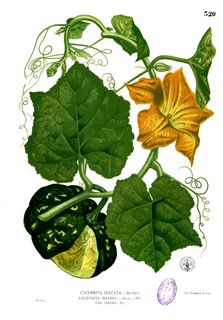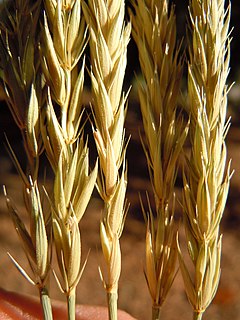
A seed is an embryonic plant enclosed in a protective outer covering . The formation of the seed is part of the process of reproduction in seed plants, the spermatophytes, including the gymnosperm and angiosperm plants.

A cotyledon is a significant part of the embryo within the seed of a plant, and is defined as "the embryonic leaf in seed-bearing plants, one or more of which are the first leaves to appear from a germinating seed." The number of cotyledons present is one characteristic used by botanists to classify the flowering plants (angiosperms). Species with one cotyledon are called monocotyledonous ("monocots"). Plants with two embryonic leaves are termed dicotyledonous ("dicots").

The lentil is an edible legume. It is a bushy annual plant known for its lens-shaped seeds. It is about 40 cm (16 in) tall, and the seeds grow in pods, usually with two seeds in each.

Germination is the process by which an organism grows from a seed or similar structure. The most common example of germination is the sprouting of a seedling from a seed of an angiosperm or gymnosperm. In addition, the growth of a sporeling from a spore, such as the spores of hyphae from fungal spores, is also germination. Thus, in a general sense, germination can be thought of as anything expanding into greater being from a small existence or germ.

Plant nutrition is the study of the chemical elements and compounds necessary for plant growth, plant metabolism and their external supply. In 1972, Emanuel Epstein defined two criteria for an element to be essential for plant growth:
- in its absence the plant is unable to complete a normal life cycle.
- or that the element is part of some essential plant constituent or metabolite.

The endosperm is a tissue produced inside the seeds of most of the flowering plants following fertilization. It surrounds the embryo and provides nutrition in the form of starch, though it can also contain oils and protein. This can make endosperm a source of nutrition in animal diet. For example, wheat endosperm is ground into flour for bread, while barley endosperm is the main source of sugars for beer production. Other examples of endosperm that forms the bulk of the edible portion are coconut "meat" and coconut "water", and corn. Some plants, such as orchids, lack endosperm in their seeds.

Nelumbo nucifera, also known as Indian lotus, sacred lotus, bean of India, Egyptian bean or simply lotus, is one of two extant species of aquatic plant in the family Nelumbonaceae. It is often colloquially called a water lily. Under favorable circumstances the seeds of this aquatic perennial may remain viable for many years, with the oldest recorded lotus germination being from that of seeds 1,300 years old recovered from a dry lakebed in northeastern China.

A pumpkin seed, also known as a pepita, is the edible seed of a pumpkin or certain other cultivars of squash. The seeds are typically rather flat and asymmetrically oval, and light green in color and may have a white outer hull. Some cultivars are hulless, and are grown only for their seed. The seeds are nutrient-rich, with especially high content of protein, dietary fiber and numerous micronutrients. The word can refer either to the hulled kernel or unhulled whole seed, and most commonly refers to the roasted end product.

Welwitschiaceae is a family of plants of the order Gnetales with one living species, Welwitschia mirabilis, found in southwestern Africa. Three fossil species have been recovered from the Crato Formation – late Aptian strata located in the Araripe Basin in northeastern Brazil.

A seedling is a young plant sporophyte developing out of a plant embryo from a seed. Seedling development starts with germination of the seed. A typical young seedling consists of three main parts: the radicle, the hypocotyl, and the cotyledons. The two classes of flowering plants (angiosperms) are distinguished by their numbers of seed leaves: monocotyledons (monocots) have one blade-shaped cotyledon, whereas dicotyledons (dicots) possess two round cotyledons. Gymnosperms are more varied. For example, pine seedlings have up to eight cotyledons. The seedlings of some flowering plants have no cotyledons at all. These are said to be acotyledons.
Acotyledon is used to refer to seed plants or spermatophytes that lack cotyledons, such as orchids and dodder. Orchid seeds are tiny with underdeveloped embryos. They depend on mycorrhizal fungi for their early nutrition so are myco-heterotrophs at that stage.

Banksia petiolaris is a species of flowering plant of the family Proteaceae native to Western Australia, where it is found in sandy soils in the south coastal regions from Munglinup east to Israelite Bay. It was first described by Victorian state botanist Ferdinand von Mueller in 1864, and no subspecies are recognised. B. petiolaris is one of several closely related species that all grow as prostrate shrub, with horizontal stems and thick, leathery upright leaves. Those of this species can be viable for up to 13 years—the longest-lived of any flowering plant recorded. It bears yellow cylindrical flower spikes, known as inflorescences, up to 16 cm high in spring. As the spikes age, they turn grey and develop up to 20 woody seed pods, known as follicles, each.

Tylosema esculentum, with common names gemsbok bean and marama bean, is a long-lived perennial legume native to arid areas of southern Africa. Stems grow at least 3 metres, in a prostrate or trailing form, with forked tendrils that facilitate climbing. A raceme up to 25 millimetres (1 in) long, containing many yellow-orange flowers, ultimately produces an ovate to circular pod, with large brownish-black seeds.

Tillandsia recurvata, commonly known as small ballmoss or ball moss, is a flowering plant in the family Bromeliaceae that grows upon larger host plants. It grows well in areas with low light, little airflow, and high humidity, which is commonly provided by southern shade trees, often the southern live oak. It is not a parasite like mistletoe, but an epiphyte like its relative Spanish moss.

Cucurbita foetidissima is a tuberous xerophytic plant found in the central and southwestern United States and northern Mexico. It has numerous common names, including: buffalo gourd, calabazilla, chilicote, coyote gourd, fetid gourd, fetid wild pumpkin, Missouri gourd, prairie gourd, stinking gourd, wild gourd, and wild pumpkin. The type specimen was collected from Mexico by Humboldt and Bonpland sometime before 1817.

Cucurbita maxima, one of at least four species of cultivated squash, is one of the most diverse domesticated species. This species originated in South America from the wild Cucurbita andreana over 4000 years ago. The two species hybridize quite readily but have noticeably different calcium levels.
Pythium graminicola is a plant pathogen infecting cereals.

Psathyrostachys juncea is a species of grass known by the common name Russian wildrye. It was formerly classified as Elymus junceus. It is native to Russia and China, and has been introduced to other parts of the world, such as Canada and the United States. Psathyrostachys juncea is a great source of food for grazing animals, as it has high nutrition value in its dense basal leaves, even in the late summer and autumn seasons. This species can grow and prosper in many harsh environments, making it an ideal candidate for improvement as it can grow in areas were farming is difficult. This species is a drought-resistant forage plant and can survive during the cool seasons. It is also a cross-pollinator and is self-sterile. This means that P. juncea cannot self-fertilize; it must find another plant of the same species with which to exchange gametes. Self-sterilization increases the genetic diversity of a species.

Cucurbita andreana is a plant species of the genus Cucurbita, since 1982 in the rank of a C. maxima subspecies, C. maxima subsp. andreana, the wild relative of C. maxima subsp. maxima cultivated subspecies. It is native to Argentina and Uruguay. C. andreana fruits are smaller and not palatable, those of C. maxima are bigger and palatable.




















